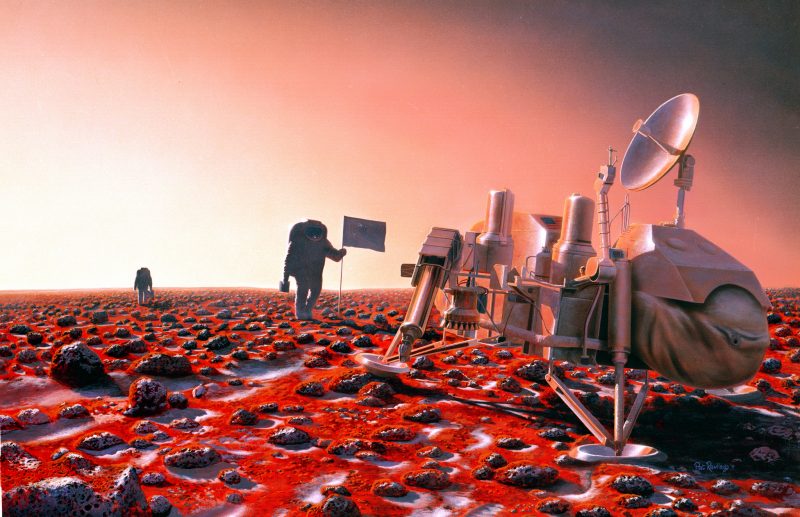- NASA has finally revealed details about its plan to send astronauts to Mars. The plan calls for building an outpost to orbit the moon and test Mars hardware. A crew of four may have to spend up to three years inside of a Mars spaceship – yet never land on the planet. It remains to be seen if NASA’s flat budget can facilitate reaching Mars by 2033.
For years, NASA has talked about sending people to Mars with its gigantic new rocket, the Space Launch System, and a new spacecraft called Orion.
But NASA hasn’t said exactly how it plans to use this hardware, which it’s spending $40 billion to develop – not even with the publication of a 36-page Mars exploration plan in October 2015.
Fortunately, a plan may finally be coming into place.
On March 21, President Donald Trump signed a law that mandates NASA send people to Mars by 2033. Then, a week later, the space agency published its most detailed plan yet for reaching the red planet.
The scheme is neither for the claustrophobic nor the faint of heart. It involves locking astronauts into a tube-shaped spaceship, sending them into deep space for three years, and giving them no form of emergency escape beyond the moon.
What's more, astronauts would only orbit Mars in 2033 - they'd never attempt a landing.
That's according to a document by William Gerstenmaier, the head of NASA's human exploration and operations directorate, that he presented during a NASA advisory council meeting on March 28. We learned about the presentation via a story by Eric Berger at Ars Technica.
"NASA is leading the next steps into deep space near the moon, where astronauts will build and begin testing the systems needed for challenging missions to deep space destinations including Mars," NASA said about the plan in a press release.
Getting to Mars in five phases

Gesternmeier's program lists five phases to reach Mars.
Phase 0 involves using the International Space Station "as a test bed to demonstrate key exploration capabilities and operations, and foster an emerging commercial space industry" with partners like SpaceX, Boeing, Orbital ATK, and others. We're currently in this phase.
Phase 1 is ambitious, involving six launches between 2018 and 2025.
First, NASA wants to launch its inaugural SLS rocket, a 321-foot behemoth that's designed to rival the Saturn V rockets that blasted Apollo astronauts to the moon. If the maiden flight and tests of its Orion spaceship went well, the space agency would launch five more SLS rockets.
The first of those five would send NASA's unrelated Europa Clipper probe to Jupiter, where it would study an icy moon with a hidden ocean that may be habitable to alien life. Four other missions would each launch a piece of a new space station, called the Deep Space Gateway, into orbit near the moon - a region called cislunar space - where four astronauts would help assemble and provision it.
"The gateway could move to support robotic or partner missions to the surface of the moon, or to a high lunar orbit to support missions departing from the gateway to other destinations in the solar system," Gerstenmaier said in the release.

Phase 2 would build on the lunar space station by launching a Deep Space Transport to it in 2027. Then, around 2028 or 2029, four lucky astronauts would spend up to 400 days inside the 41-ton tube as it orbits near the moon. Their mission: make sure the DST works and nothing critical stops working.
Phase 3 would begin around 2030, assuming the DST and its crew experienced no problems. Another SLS flight would restock the spaceship with supplies and fuel, then yet another launch would load it with four people - the first crew to visit Mars.
Their two- to three-year flight "would likely involve a Venus flyby and a short stay around Mars" and "would offer no hope for an emergency return once the crew leaves cislunar space," Berger wrote.
Phase 4 would happen beyond 2033 and is fairly nebulous at this point. All it calls for in Gerstenmaier's document is "development and robotic preparatory missions" to deliver habitats and supplies to the surface of Mars, plus eventual "Mars human landing missions."
Will NASA put the first boots on Mars?

It remains to be seen whether NASA can pull off this grand plan on the relatively flat budget Congress keeps handing it.
During the Apollo moon missions, NASA made up more than 4% of the US budget. Today, its share has shrunk to about half a percent.
Even if NASA manages to execute this plan, it may have competition from the private partners it hopes to involve. The private sector may even beat NASA to Mars.
Elon Musk, the founder of the rocket company SpaceX, recently said he planned to send people to Mars by 2022. Boeing has also challenged SpaceX in getting to the red planet. Musk said he was OK with this because all he wanted to do was colonize Mars and protect humanity from self-imposed annihilation or a rogue asteroid.
"I think it's good for there to be multiple paths to Mars ... to have multiple irons in the fire," Musk said in August.

